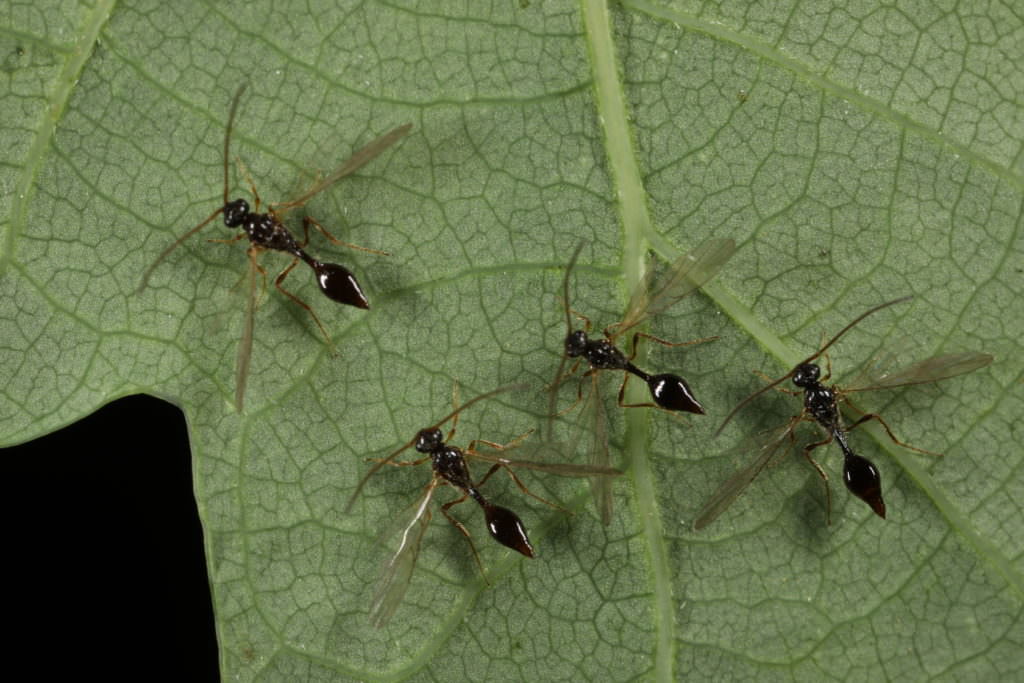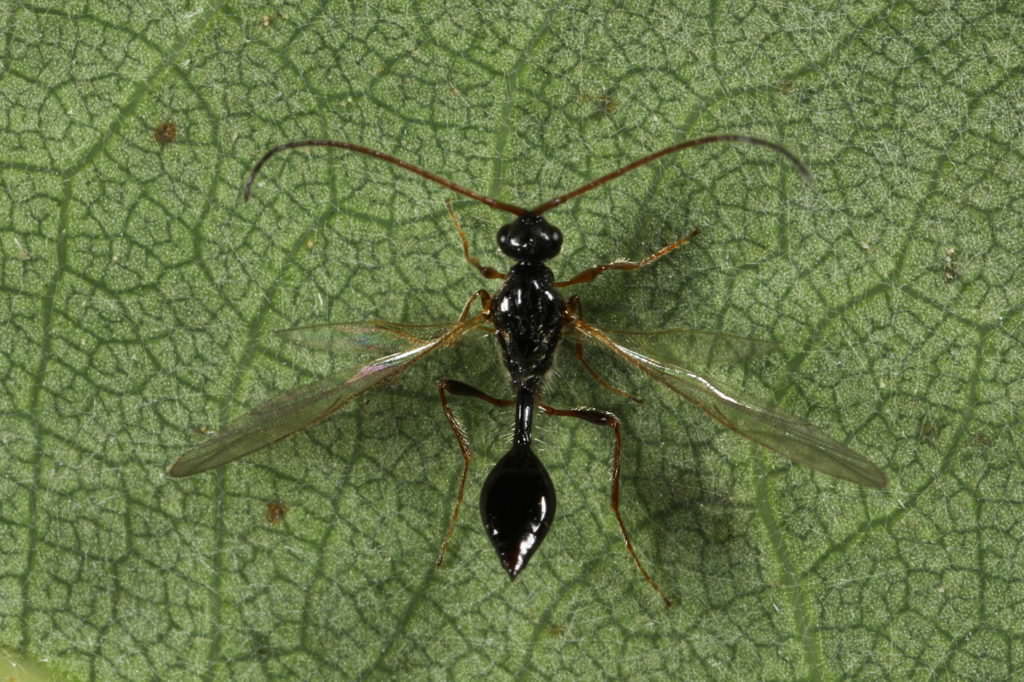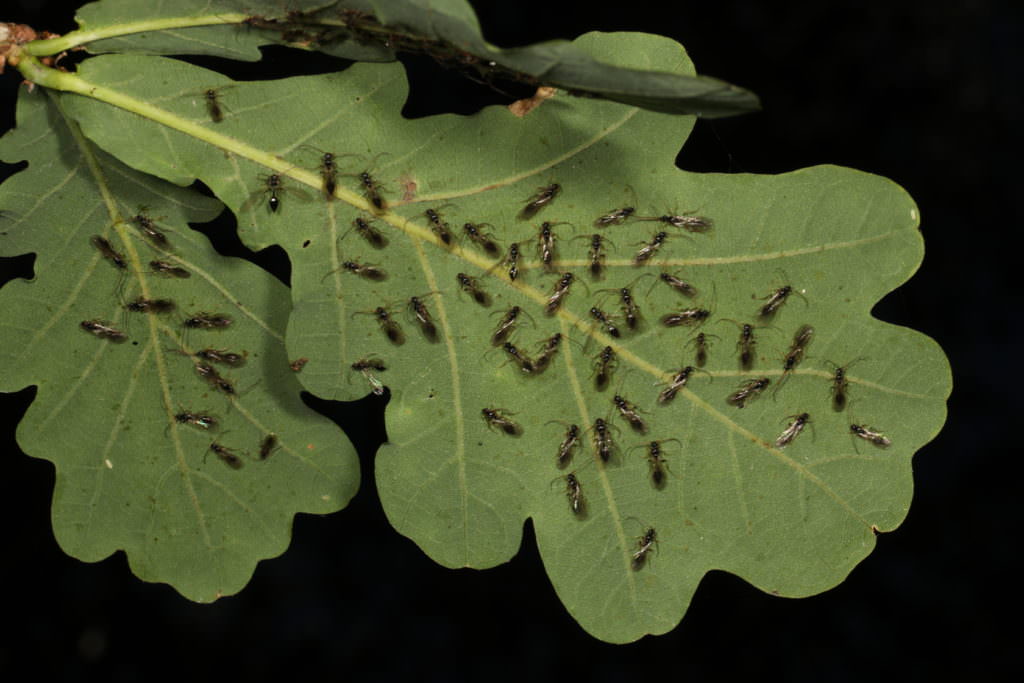With the warmer than normal summer weather we’ve had here at Findhorn this year, it has been an unusual and different season for biodiversity, and especially insects, on the Hinterland area. For example, one of my main insect groups of interest – aphids – have been conspicuous largely by their absence. Only a few of the most common and abundant species have been visible, and it’s likely that for many aphid species the relatively dry summer that we’ve had has limited the opportunities for their populations to get established.
Other groups appear to have done much better. For example, there’s been a lot of shieldbugs in evidence, especially on the group of large birch trees near the central wind turbine, where large numbers of both red-legged shieldbugs (Pentatoma rufipes) and birch shieldbugs (Elasmostethus interstinctus) have reproduced successfully. These brightly-coloured bugs go through several developmental stages of growth, in which they are known as nymphs, before pupating into their adult forms.
On the 1st of August I came across some unusual wasps on the underside of the leaves of a whitebeam tree (Sorbus aria) in the ‘Fallen Acres’ area of the Findhorn Hinterland. This is the part of the land where a storm blew down all the conifers about 20 years ago, and there was subsequent abundant natural regeneration of native trees such as birch, complemented by the planting of some other broadleaves, including whitebeams and oaks (Quercus robur). These wasps caught my eye as I hadn’t seen any like them before. At just under 1cm. in body length they each had a classic ‘wasp waist’ and a distinctively-shaped abdomen, and there were quite a few of them grouped together on some of the leaves.

Female parasitoid wasps (Cinetus iridipennis) (Diapriidae) on the underside of an oak leaf on the Findhorn Hinterland on 23rd August 2022.
In the following weeks I monitored them closely, and soon found that there were much larger numbers of them on the undersides of the leaves of some nearby young oaks, where they were gathered together in large, dense clusters. I posted photographs of them on Twitter, tagging a wasp specialist who has helped me with identifications before. He said they were wasps in the family Diapriidae (which he isn’t able to identify – there are over 7,000 wasp species in the UK!) but he referred me on to David Notton, whom he thought may be able to help. I sent David some specimens and he identified them as a parasitoid species of wasp called Cinetus iridipennis (there is no common name for the species). Interestingly enough, the wasps were all females, and he thought they may be roosting en masse under the leaves to take advantage of the greater humidity immediately under the leaves, to prevent themselves from drying out. A similar behaviour has been noted before in Germany for a closely-related species, Cinetus cameroni. There were no wasps on the undersides of the leaves of birch and rowan trees nearby, indicating that the size of the leaf they were sheltering under was important.

Close-up of one of the female parasitoid wasps (Cinetus iridipennis) (Diapriidae) on the underside of an oak leaf (Quercus robur) on 19th August 2022.
Checking the NBN Atlas for Cinetus iridipennis revealed that there are only 16 records for this species in the UK, and just one in Scotland, from a site at the head of the Beauly Firth, just east of Inverness. According to David Notton this species is actually relatively common, but is significantly under-recorded, possibly because there are so few people who can identify a wasp like this. As a parasitoid species, the female injects her eggs into the larvae of other insects (in this case a member of the Diptera, or two-winged flies), and as each wasp larva develops it kills the host insect it is growing inside. When I asked about the fact they were all females, David replied that many species of Hymenoptera (as wasps are known in scientific terms) have different flight times for male and females, and that the females can persist for a long period after they have been impregnated by the males.

Female parasitoid wasps (Cinetus iridipennis) (Diapriidae) clustered densely together on the underside of the leaves of an oak tree (Quercus robur) on the Findhorn Hinterland on 10th August 2022.
I checked the trees where I found them quite regularly in the following weeks and although the numbers visible there reduced significantly, there were still some to be seen in mid-September, about 6 weeks after I’d first spotted them. I wasn’t able to find out what species they were parasitising so that’s still a mystery. Another unknown is the reason why there were such large numbers of them clustered so closely together on the oak leaves. It’s all part of the mystery and wonder of Nature, and we hope that through our ongoing work on the Hinterland we’ll be able, over time, to document and understand the reasons for phenomena like this.
Alan Watson Featherstone,
FHT Trustee & Chair of the Land Management subgroup.

















FHT Biodiversity – Summer Discoveries
With the warmer than normal summer weather we’ve had here at Findhorn this year, it has been an unusual and different season for biodiversity, and especially insects, on the Hinterland area. For example, one of my main insect groups of interest – aphids – have been conspicuous largely by their absence. Only a few of the most common and abundant species have been visible, and it’s likely that for many aphid species the relatively dry summer that we’ve had has limited the opportunities for their populations to get established.
Other groups appear to have done much better. For example, there’s been a lot of shieldbugs in evidence, especially on the group of large birch trees near the central wind turbine, where large numbers of both red-legged shieldbugs (Pentatoma rufipes) and birch shieldbugs (Elasmostethus interstinctus) have reproduced successfully. These brightly-coloured bugs go through several developmental stages of growth, in which they are known as nymphs, before pupating into their adult forms.
On the 1st of August I came across some unusual wasps on the underside of the leaves of a whitebeam tree (Sorbus aria) in the ‘Fallen Acres’ area of the Findhorn Hinterland. This is the part of the land where a storm blew down all the conifers about 20 years ago, and there was subsequent abundant natural regeneration of native trees such as birch, complemented by the planting of some other broadleaves, including whitebeams and oaks (Quercus robur). These wasps caught my eye as I hadn’t seen any like them before. At just under 1cm. in body length they each had a classic ‘wasp waist’ and a distinctively-shaped abdomen, and there were quite a few of them grouped together on some of the leaves.
Female parasitoid wasps (Cinetus iridipennis) (Diapriidae) on the underside of an oak leaf on the Findhorn Hinterland on 23rd August 2022.
In the following weeks I monitored them closely, and soon found that there were much larger numbers of them on the undersides of the leaves of some nearby young oaks, where they were gathered together in large, dense clusters. I posted photographs of them on Twitter, tagging a wasp specialist who has helped me with identifications before. He said they were wasps in the family Diapriidae (which he isn’t able to identify – there are over 7,000 wasp species in the UK!) but he referred me on to David Notton, whom he thought may be able to help. I sent David some specimens and he identified them as a parasitoid species of wasp called Cinetus iridipennis (there is no common name for the species). Interestingly enough, the wasps were all females, and he thought they may be roosting en masse under the leaves to take advantage of the greater humidity immediately under the leaves, to prevent themselves from drying out. A similar behaviour has been noted before in Germany for a closely-related species, Cinetus cameroni. There were no wasps on the undersides of the leaves of birch and rowan trees nearby, indicating that the size of the leaf they were sheltering under was important.
Close-up of one of the female parasitoid wasps (Cinetus iridipennis) (Diapriidae) on the underside of an oak leaf (Quercus robur) on 19th August 2022.
Checking the NBN Atlas for Cinetus iridipennis revealed that there are only 16 records for this species in the UK, and just one in Scotland, from a site at the head of the Beauly Firth, just east of Inverness. According to David Notton this species is actually relatively common, but is significantly under-recorded, possibly because there are so few people who can identify a wasp like this. As a parasitoid species, the female injects her eggs into the larvae of other insects (in this case a member of the Diptera, or two-winged flies), and as each wasp larva develops it kills the host insect it is growing inside. When I asked about the fact they were all females, David replied that many species of Hymenoptera (as wasps are known in scientific terms) have different flight times for male and females, and that the females can persist for a long period after they have been impregnated by the males.
Female parasitoid wasps (Cinetus iridipennis) (Diapriidae) clustered densely together on the underside of the leaves of an oak tree (Quercus robur) on the Findhorn Hinterland on 10th August 2022.
I checked the trees where I found them quite regularly in the following weeks and although the numbers visible there reduced significantly, there were still some to be seen in mid-September, about 6 weeks after I’d first spotted them. I wasn’t able to find out what species they were parasitising so that’s still a mystery. Another unknown is the reason why there were such large numbers of them clustered so closely together on the oak leaves. It’s all part of the mystery and wonder of Nature, and we hope that through our ongoing work on the Hinterland we’ll be able, over time, to document and understand the reasons for phenomena like this.
Alan Watson Featherstone,
FHT Trustee & Chair of the Land Management subgroup.